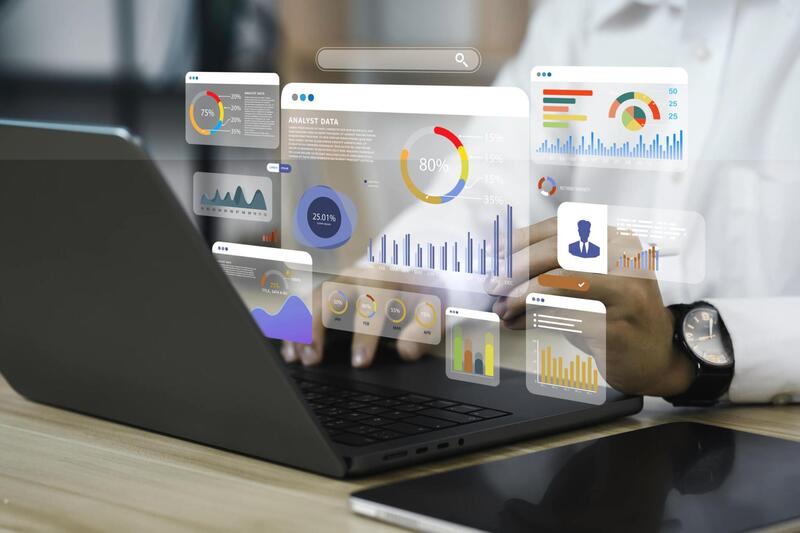Introduction:
In an era of rapid technological advancements and evolving business landscapes, the role of Human Resources (HR) has undergone a paradigm shift. No longer confined to traditional administrative functions, HR now plays a pivotal role in shaping organizational strategies. One of the key enablers of this transformation is HR analytics, a data-driven approach that provides valuable insights into workforce dynamics. As we step into 2024, the significance of HR analytics in strategic decision-making continues to grow. In this blog, we explore the trends that will shape the landscape of HR analytics in the coming year.
Understanding the Continued Importance of HR Analytics
Shifting from Reactive to Proactive Decision-Making
Historically, HR functions were reactive, responding to workforce issues as they arose. With HR analytics, organizations can now transition from a reactive stance to a proactive one. By analyzing historical data and identifying patterns, HR professionals can anticipate future challenges and devise strategies to address them before they become critical issues.

Aligning HR with Organizational Goals
HR analytics plays a crucial role in aligning HR strategies with overall organizational objectives. By tracking key performance indicators (KPIs) and assessing how HR initiatives contribute to business goals, organizations can optimize their workforce to drive success.
Enhancing Employee Experience
Employee experience has emerged as a focal point for organizations aiming to attract and retain top talent. HR analytics enables a deep dive into various facets of the employee lifecycle, from recruitment to off boarding, helping organizations enhance employee satisfaction and engagement.
Trends Shaping HR Analytics in 2024
Predictive Analytics for Workforce Planning:
Predictive Analytics for Workforce Planning involves the application of advanced statistical algorithms, machine learning, and data analysis techniques to historical and current workforce data. The goal is to identify patterns, trends, and relationships that can be used to make predictions about future workforce needs, skill requirements, and potential challenges.
Key Components:
Historical Data Analysis:
Organizations analyze past workforce data, including employee turnover rates, recruitment success, and performance metrics. This historical data serves as the foundation for predicting future workforce trends.
Identification of Patterns and Trends:
Advanced analytics tools are employed to identify patterns and trends within the historical data. This can include recognizing factors that contribute to employee attrition, identifying high-performing teams, or understanding the skills that lead to success in specific roles.
Development of Predictive Models:
Predictive models are created using machine learning algorithms. These models take into account various factors such as employee demographics, performance metrics, and market conditions to predict future workforce needs. They can forecast areas of talent shortages, potential skill gaps, and the impact of external factors on the workforce.
Proactive Decision-Making:
Armed with insights from predictive analytics, HR professionals and organizational leaders can make proactive decisions. For example, they can anticipate which roles may face a shortage of qualified candidates in the future and implement strategies for recruitment and talent development well in advance.
Strategic Workforce Planning:
Predictive analytics shifts workforce planning from a reactive approach to a strategic one. Instead of addressing workforce issues as they arise, organizations can strategically plan for future needs, ensuring they have the right talent in the right positions to meet organizational goals.
Benefits and Significance:
Optimized Recruitment and Training:
Organizations can optimize their recruitment efforts by identifying the skills and attributes that lead to success in specific roles. This allows for targeted hiring and training programs to address potential skill gaps.
Cost Savings:
Predictive analytics helps organizations avoid unnecessary costs associated with reactive workforce management. By anticipating future needs, they can allocate resources efficiently and avoid the expenses related to sudden talent shortages or excessive recruitment efforts.
Improved Employee Retention:
By identifying factors contributing to employee turnover, organizations can implement strategies to improve retention. This may include targeted interventions for at-risk employees or adjustments to the work environment based on predictive insights.
Strategic Alignment:
Predictive analytics aligns HR strategies with overall organizational objectives. It ensures that the workforce is strategically aligned with the business goals, contributing to the overall success and competitiveness of the organization.

Embracing Artificial Intelligence (AI) and Machine Learning (ML) in HR Analytics:
Embracing Artificial Intelligence (AI) and Machine Learning (ML) in HR analytics involves the integration of advanced technologies to analyze and interpret large datasets related to the workforce. AI and ML algorithms are applied to gain deeper insights into employee behavior, predict future trends, and enhance decision-making processes within the human resources domain.
Key Components:
Advanced Data Analysis:
AI and ML enable more sophisticated analysis of HR data. These technologies go beyond traditional analytics by identifying complex patterns, correlations, and trends within vast datasets. This includes analyzing employee performance, engagement, and other relevant metrics.
Predictive Analytics:
AI and ML algorithms are utilized for predictive analytics in HR. By learning from historical data, these technologies can predict future outcomes, such as identifying employees at risk of leaving the organization, forecasting recruitment needs, or suggesting personalized development paths for individuals.
Talent Acquisition and Recruitment:
AI is employed in talent acquisition to streamline the recruitment process. This includes automated resume screening, candidate matching, and even chatbots for initial candidate interactions. ML algorithms can identify the most suitable candidates based on historical hiring data and the organization's specific criteria.
Employee Engagement and Satisfaction:
AI and ML contribute to understanding and improving employee engagement. These technologies can analyze employee feedback, sentiment, and behavior to identify factors influencing engagement levels. Insights gained can inform HR strategies to enhance overall employee satisfaction.
Personalized Learning and Development:
AI and ML enable the creation of personalized learning paths for employees. By analyzing individual skills, performance, and career aspirations, these technologies recommend tailored training programs, helping employees enhance their skills in areas relevant to their roles.
Succession Planning:
AI and ML play a role in succession planning by identifying high-potential employees and potential future leaders within the organization. These technologies can assess performance, skills, and leadership qualities to create a more accurate succession plan.
Benefits and Significance:
Efficiency and Automation:
AI and ML automate routine HR tasks, such as resume screening and initial candidate communication, allowing HR professionals to focus on more strategic and value-added activities.
Data-Driven Decision-Making:
By analyzing vast datasets, AI and ML empower HR professionals to make data-driven decisions. This ensures that decisions related to talent management, recruitment, and employee development are based on objective insights.
Enhanced Accuracy and Precision:
AI and ML algorithms can analyze large amounts of data with a high level of accuracy. This reduces the likelihood of human error and enhances the precision of predictions and recommendations.
Adaptability to Change:
AI and ML in HR analytics provide organizations with the flexibility to adapt to changing market conditions and workforce dynamics. These technologies enable quick adjustments to strategies based on real-time insights.
Competitive Advantage:
Organizations that embrace AI and ML in HR gain a competitive advantage by staying ahead in terms of talent acquisition, employee engagement, and strategic workforce planning. These technologies contribute to organizational agility and innovation.
Focus on Diversity, Equity, and Inclusion (DEI) Analytics:
Focus on Diversity, Equity, and Inclusion (DEI) Analytics involves the use of data-driven approaches to measure, monitor, and enhance diversity, equity, and inclusion within an organization. This strategic use of analytics helps organizations assess their current state, identify areas for improvement, and implement targeted initiatives to foster a more diverse, equitable, and inclusive workplace.
Key Components:
Data Collection and Metrics:
DEI Analytics begins with the collection of relevant data. This includes demographic information, such as gender, ethnicity, age, and other diversity factors. Metrics related to representation at various organizational levels, pay equity, and employee experiences are also crucial.
Benchmarking and Goal Setting:
Organizations use DEI analytics to benchmark their current diversity and inclusion metrics against industry standards or their own historical data. Based on these benchmarks, organizations set specific, measurable, and achievable goals to improve diversity, equity, and inclusion within the workforce.
Identifying Disparities:
DEI Analytics helps identify disparities within the organization. This could involve analyzing representation gaps, pay disparities, or differences in promotion rates among various demographic groups. Identifying these disparities is the first step toward addressing them.
Employee Experience Analysis:
DEI Analytics extends to analyzing the employee experience, including factors such as satisfaction, engagement, and perceptions of inclusivity. Surveys and feedback mechanisms may be used to gather qualitative data that complements quantitative metrics.
Impact Assessment:
Organizations use DEI analytics to assess the impact of diversity and inclusion initiatives. This involves measuring changes in key metrics over time, such as improvements in representation, pay equity, and overall employee satisfaction.
Continuous Improvement:
DEI Analytics is an iterative process. Organizations continuously analyze data to track progress and identify areas for further improvement. This approach ensures that diversity, equity, and inclusion remain central to the organizational culture.
Benefits and Significance:
Informed Decision-Making:
DEI Analytics provides organizations with the data needed for informed decision-making. Leaders can use these insights to make strategic decisions that foster a more inclusive and equitable workplace.
Mitigation of Unconscious Bias:
By identifying and addressing disparities in hiring, promotions, and compensation, DEI Analytics helps mitigate unconscious bias. This contributes to a fairer and more transparent organizational culture.
Enhanced Talent Acquisition and Retention:
Organizations that prioritize DEI analytics are better positioned to attract and retain diverse talent. A commitment to diversity and inclusion is increasingly important for employees, and DEI initiatives can positively impact employer brand and reputation.
Legal Compliance:
DEI Analytics assists organizations in ensuring compliance with diversity and inclusion-related regulations. By proactively addressing potential issues, organizations reduce the risk of legal challenges related to discrimination and inequity.
Cultural Transformation:
DEI Analytics supports cultural transformation by fostering a workplace culture that values diversity and inclusion. It encourages open dialogue, awareness, and education, leading to a more positive and inclusive work environment.
Alignment with Organizational Values:
Organizations that focus on DEI analytics demonstrate a commitment to values such as fairness, equality, and social responsibility. This alignment can resonate positively with both employees and external stakeholders.
Real-time Analytics for Agile Decision-Making:
Real-time Analytics for Agile Decision-Making refers to the use of advanced data analytics techniques to process and analyze data as it is generated, providing up-to-the-minute insights. In the context of Human Resources (HR), this approach enables HR professionals to make swift and informed decisions in response to rapidly changing market conditions, regulatory requirements, and internal dynamics.

Key Components:
Continuous Data Monitoring:
Real-time analytics involves continuous monitoring of HR-related data, including employee performance metrics, recruitment data, employee sentiment, and other relevant workforce information. This constant flow of data ensures that decision-makers have the latest information at their disposal.
Dynamic Dashboard Reporting:
Dashboards and reporting tools are utilized to display key HR metrics and insights in real-time. This visual representation allows HR professionals and organizational leaders to quickly grasp the current state of the workforce and identify trends or anomalies that may require immediate attention.
Predictive Analytics in Real Time:
Real-time analytics goes beyond descriptive analytics by incorporating predictive capabilities. Predictive models can provide insights into future workforce trends, allowing HR professionals to anticipate challenges and proactively address issues before they escalate.
Employee Feedback and Engagement:
Gathering and analyzing real-time feedback from employees is a crucial component. This can involve sentiment analysis of employee communications, surveys, or feedback from collaboration platforms. Identifying issues promptly allows for timely interventions to enhance employee engagement.
Market and Competitor Analysis:
Real-time analytics extends beyond internal data to include external factors. HR professionals can monitor market trends, competitor practices, and industry benchmarks in real time. This information is valuable for adjusting HR strategies to align with external dynamics.
Agile Decision-Making Processes:
Real-time analytics supports agile decision-making processes by providing immediate insights. This agility is crucial in responding to emerging challenges, adjusting HR policies, and making timely decisions that impact workforce management.
Benefits and Significance:
Swift Response to Market Changes:
Real-time analytics enables HR professionals to respond swiftly to changes in the external environment, such as shifts in market demand, talent availability, or regulatory requirements. This agility is essential for staying competitive.
Proactive Issue Resolution:
By identifying trends and potential issues in real time, HR can take a proactive approach to issue resolution. This minimizes the impact of challenges and prevents them from escalating into more significant problems.
Enhanced Employee Experience:
Timely insights into employee sentiment and engagement allow HR to address concerns promptly, leading to an enhanced employee experience. This responsiveness contributes to a positive workplace culture.
Optimized Resource Allocation:
Real-time analytics helps optimize resource allocation by providing insights into workforce productivity, performance, and skill utilization. This ensures that resources are deployed efficiently to meet organizational goals.
Improved Organizational Agility:
The ability to make quick and well-informed decisions based on real-time data contributes to overall organizational agility. HR can adapt strategies, policies, and initiatives promptly to align with changing business conditions.
Strategic Alignment with Business Goals:
Real-time analytics facilitates the alignment of HR strategies with broader organizational goals. This alignment ensures that workforce management contributes directly to the achievement of business objectives.
Conclusion
In the ever-evolving landscape of business, the role of HR analytics in strategic decision-making is indispensable. As we look ahead to 2024, organizations that embrace the trends in HR analytics will be better positioned to navigate uncertainties, optimize their workforce, and achieve sustainable success. By leveraging predictive analytics, embracing AI and ML, focusing on DEI analytics, and adopting real-time analytics, HR professionals can contribute significantly to organizational strategies and drive positive outcomes. As the digital era unfolds, HR analytics stands as a beacon guiding organizations toward a future where decisions are not just informed by data but empowered by it.
Newsletter to recieve
our latest company updates
Comment